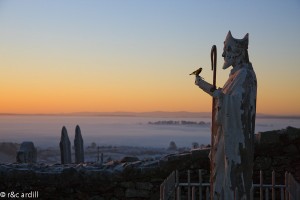Notes on the Notes – February 24, 2013
Lent 2 – Theme: Taking the hard way can be the right way!
Readings: Philippians 3:17-4:1, Luke 13:31-35
This week’s music:
“O Master, Let Me Walk with Thee” (VU #560) – The author, Washington Gladden, was an American Congregational minister and a leader of the social gospel movement. This text, from a devotional poem entitled “Walking with God,” was first published in his periodical, The Sunday Afternoon (1879). It was not originally intended to be set as a hymn, but was meant as a daily devotion. The text comes from a period of religious history in the United States when there was much emphasis given to the social implications of the Gospel. The Civil War had ended and the country was in the throes of a great industrial revolution. The tune, MARYTON, was composed by Henry Percy Smith, a Church of England vicar.
“Take Up Your Cross” (VU #561) – Charles Everest, a graduate of Trinity College, Hartford, was rector of a parish in Hamden, Connecticut for thiry-one years. He wrote this sermon in verse at the age of nineteen and published it in his anthology, Visions of Death and other Poems (1833). The tune, HESPERUS, was composed by Henry Baker, a civil engineer, during his undergraduate years at Exeter College, Oxford. It was first published anonymously in 1866.
“Thy Will Be Done” – This anthem was written by Joyce Elaine Eilers in 1975. It is an intimate prayer for strength in times of difficulty, and includes a setting of The Lord’s Prayer.
The Lord’s Prayer is a central prayer in Christianity. It appears in two forms in the Bible: in the Gospel of Matthew as part of the Sermon on the Mount, and in the Gospel of Luke, which records Jesus being approached by “one of his disciples” with a request to teach them “to pray as John taught his disciples.” The first three of the seven petitions address God; the second four are prayers related to our needs and concerns. Protestants conclude the prayer with the doxology “For Thine is the Kingdom and the Power and the Glory, for ever and ever. Amen.”
|
The prayer as it occurs in Luke 11:2-4
|
On Easter Day 2007, it was estimated that many of the two billion Catholic, Anglican, Portestant and Easter Orthodox Christians who were sharing in the celebration of Easter would read, recite, or sing the short prayer in hundreds of languages. Although theological differences and various modes of worship divide Christians, “there is a sense of solidarity in knowing that Christians around the globe are praying together…, and these words always unite us.”
“Be Thou My Vision” (VU #642) – The text of this hymn is based on an eighth-century Irish poem translated into English prose by Mary E. Byrne, and published in 1905. The tune is an Irish air, arranged by David Evans for the Revised Church Hymnary (1930). Slane is the name of a hill in County Meath where St. Patrick incurred the ire of the Irish King Loegaire by igniting a fire on Easter eve before the pagan king had ordered the lighting of the royal fire on the nearby hill of Tara to signal the return of spring.
“Fire glowed against the visage of St. Patrick as he lit yet another candle in the dark Irish churchyard on Slane Hill. The fire reminded him of Christ, Redeemer and light of his life. Opposite the churchyard was Tara, where resided the pagan High King Lóegaire– the man who outlawed candles in Ireland. But it was the eve of Easter, 433 A.D. and St. Patrick was determined to glorify God that night. And thus began the hymn.”
 Statue of St. Patrick in Meath, Ireland
Statue of St. Patrick in Meath, Ireland
To hear a beautiful version of this hymn by the group Eden’s Bridge, go to http://www.youtube.com/watch?v=D_qL6FNwEsY
Categories: Notes on the Notes


You must be logged in to post a comment.